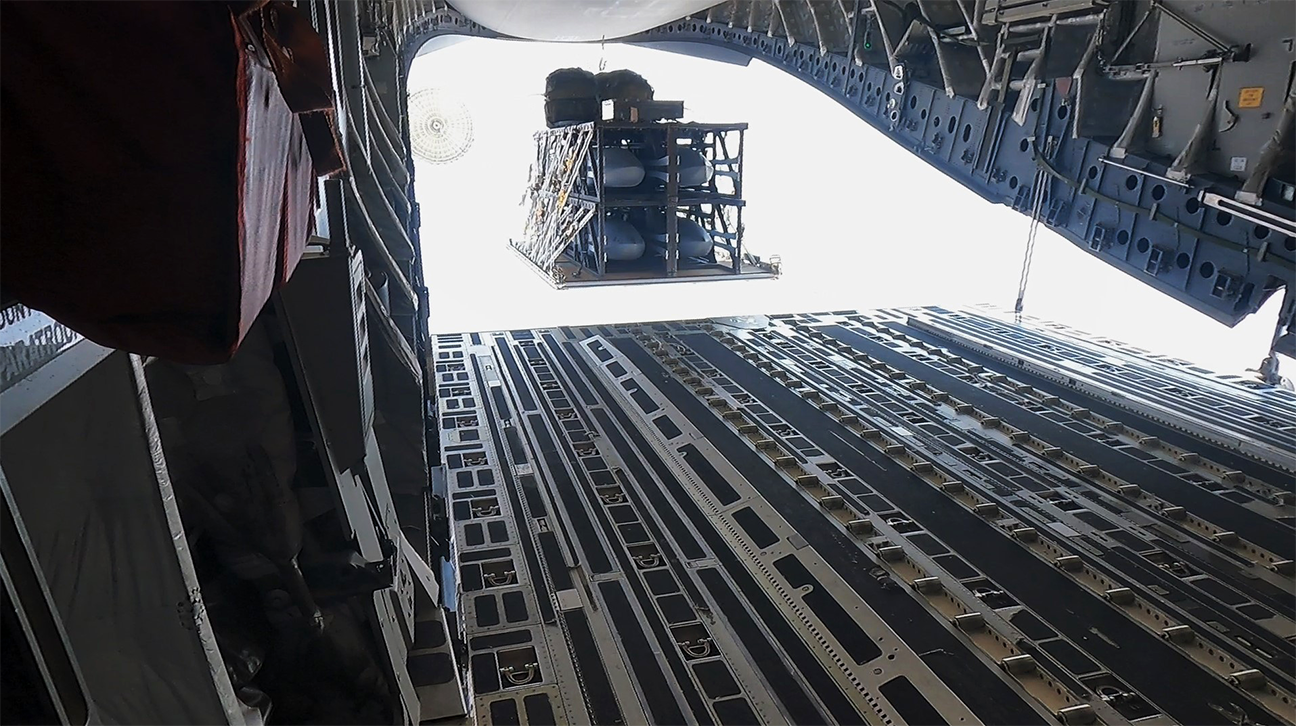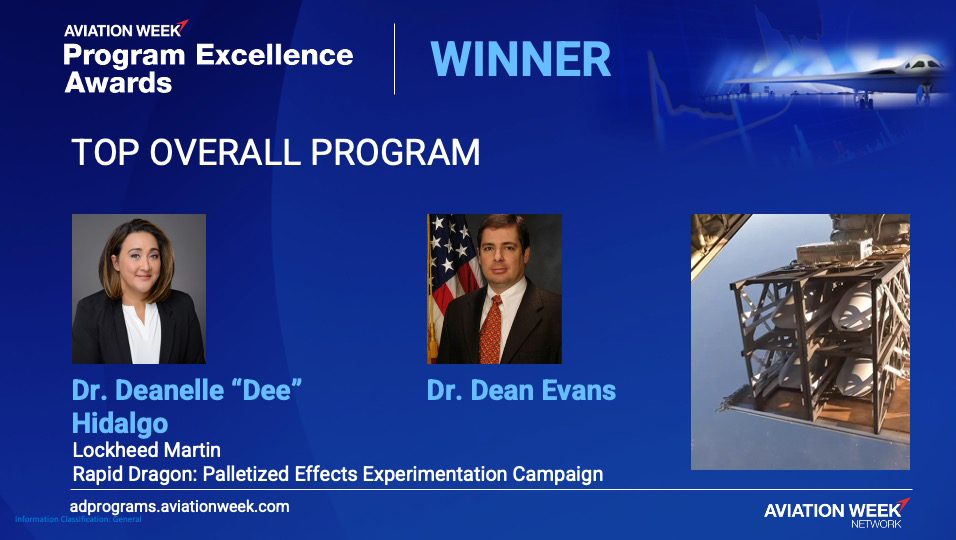WASHINGTON, D.C. (AFRL) – Lockheed Martin and the Air Force Research Laboratory’s Strategic Development Planning and Experimentation office, or SDPE, received top honors for the Rapid Dragon Palletized Munitions campaign at the Aviation Week Network 2023 Program Excellence Awards, announced Nov. 8, 2023.
Raytheon’s work on the SDPE Air Base Defense Experiment was also selected as the award winner in the Special Projects category, one of seven categories judged by an evaluation team from 11 aerospace companies.

A C-17A conducts a standard cargo airdrop of the Rapid Dragon Palletized Effects Deployment System during an experimentation flight. Rapid Dragon is the Air Force Strategic Development Planning and Experimentation office’s Palletized Effects campaign that explores the feasibility and operational advantages of airdropping palletized effects from existing airlift aircraft, such as a C-130 and C-17, without requiring modifications to the aircraft. (Courtesy photo)
The awards were announced during the annual Program Excellence Dinner and Awards Ceremony as part of Aviation Week’s Aerospace and Defense Programs Conference at the Watergate Hotel in Washington, D.C.
“The Program Excellence Awards annually showcase innovative and impactful program managers and their creative and unique approaches in leading a team to excellence,” said Joe Anselmo, editorial director and editor-in-chief for Aviation Week. “These individuals, often far from the headlines, are the backbone of an industry that has a profound impact on the world.”
Rapid Dragon is a palletized munitions experimentation campaign exploring the concept of airdropping long-range palletized weapons from unmodified existing airlift platforms, such as the C-130 and C-17. Rapid Dragon pallets are released from cargo planes before weapons are dropped and flown to intended targets.
Project managers cited in the Rapid Dragon award were Lockheed Martin’s Dr. Deanelle “Dee” Hidalgo, deputy director, Air-to-Ground Missile Systems/Rapid Dragon, and Dr. Dean Evans of the Air Force Research Laboratory Strategic Development Planning and Experimentation Office.
“I am honored that the 2023 Program Excellence Evaluation Team awarded the distinction of ‘Top Overall Program’ to Rapid Dragon, especially considering all the great topics that were finalists this year,” Evans said. “It was a surprise to receive the Top Overall Program Award, considering it has only been previously given out three times over the past two decades.”
Rapid Dragon is the result of a strong partnership between government and industry, Evans added.
“The Rapid Dragon Program has been considered as an exemplar for how to do business differently while achieving success with speed,” Evans said. “This program is a prime example of a government-industry partnership that embraced a fly-often, learn-fast mindset; built a community of subject matter experts across the DOD and industry; and executed an aggressive but well-thought-out experimentation campaign that took calculated risks.’’
He said the approach resulted in Rapid Dragon evolving from a paper-only concept in December 2019 to a successful powered-flight demonstration in less than 24 months, while remaining ahead of schedule and on budget.

Lockheed Martin’s Dr. Deanelle “Dee” Hidalgo, deputy director, Air-to-Ground Missile Systems/Rapid Dragon, and Dr. Dean Evans of the Air Force Research Laboratory’s, or AFRL, Strategic Development Planning and Experimentation Office, or SDPE, are the project managers cited in the Rapid Dragon award. Lockheed Martin and AFRL’s SDPE office, or SDPE, received top honors for the Rapid Dragon Palletized Munitions campaign at the Aviation Week Network 2023 Program Excellence Awards, announced Nov. 8, 2023. (U.S. Air Force graphic)
In the fall of 2022, the Integrated Capabilities Directorate’s SDPE office partnered in a total-force initiative to conduct the first live-fire demonstration of Rapid Dragon in the U.S.-European Command theater; in the summer of 2023, SDPE partnered with Air Mobility Command for the first live-fire demonstration of Rapid Dragon in the Indo-Pacific Command theater.
“I greatly appreciate Lockheed Martin including their government partner in the award nomination,” Evans said. “I believe this was the only case this year where the government partner was formally included – this is a testament to the strong relationship between AFRL and Lockheed Martin in developing this capability.
“We had a great team comprised of government [Air Force, Naval Surface Warfare Center-Dahlgren, and SOCOM Det. 1] and industry that made this possible,” Evans added.
Raytheon’s SDPE Air Base Air Defense Experiment award application described its role in the Trident Elding 2022 test of the National Advanced Surface-to-Air Missile System, or NASAMS, in Norway. Trident Elding confirmed that multiple base defense weapon variants can be fired from a NASAMS launcher and integrated into Air Force command and control systems.
The application cited that the Raytheon-led team designed, integrated, tested and executed the demonstration within nine months. The effort was led by Daniel T. Dyring, Raytheon’s program director for the Air Base Defense Experiment.
Jim Simonds, team lead for the SDPE Air Base Defense Experiment, said his project’s award is a testament to the dedication, ingenuity and technical expertise of the team.
“SDPE, Raytheon, Kongsberg Defense and Aerospace have worked closely over the past couple years to experiment with NASAMS integrated with USAF operationally relevant command and control capability,” Simonds said. “This Air Force/industry partnership has demonstrated the ability to rapidly experiment with proven prototypes to assess operational utility and inform strategic investment decisions.”
Simonds said the Trident Elding experiment was an example of how DOD and defense contractors can work together to rapidly address critical warfighter needs.
“To generate combat air power and execute logistics under attack, we need to protect our personnel and equipment on the ground,” Simonds said. “This partnership resulted in a key experiment that clearly identified capabilities that are ready now, fully integrated and ready to do just that.”
AFRL continues to align its science and technology research and development with Department of the Air Force Operational Imperatives and the development of asymmetric advantages for the future fight.
“While we drive for tech advantage in air, space and cyberspace, we must fight to connect across domains and enable adaptability and flexibility in capabilities,” said Maj. Gen. Scott “Nova” Cain, AFRL commander. “Our focused S&T will continue to be extraordinary, but we must think and act in a multi-disciplinary fashion to power the next fight. Congratulations to the SDPE Rapid Dragon and Air Base Air Defense teams for this well-deserved recognition.”
AFRL’s Integrated Capabilities Directorate Director Christopher Ristich said it was gratifying that Lockheed Martin and Raytheon chose to include SDPE and the program managers in their submissions to the award judges.
“That is a true testament to the close partnership, trust and respect we’ve built with industry in delivering integrated capabilities,” Ristich said.
About AFRL
The Air Force Research Laboratory, or AFRL, is the primary scientific research and development center for the Department of the Air Force. AFRL plays an integral role in leading the discovery, development and integration of affordable warfighting technologies for our air, space and cyberspace force. With a workforce of more than 12,500 across nine technology areas and 40 other operations across the globe, AFRL provides a diverse portfolio of science and technology ranging from fundamental to advanced research and technology development. For more information, visit www.afresearchlab.com.

